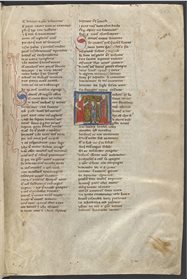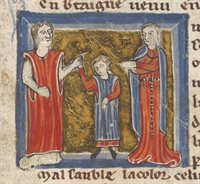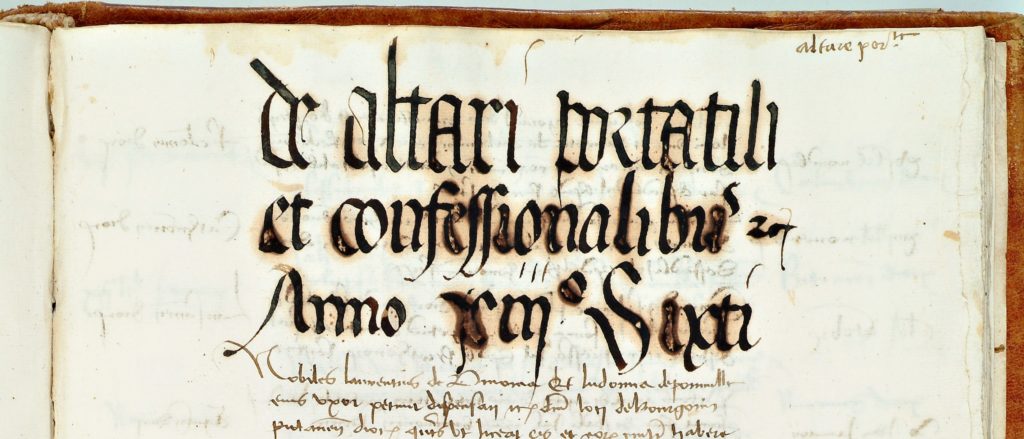Medievalists and medieval enthusiasts have no doubt encountered stories of lovers who reach an impasse between their affections for each other and deeper, more personal obligations that they may hold, whether an obligation to another, to an institution, or to God. We might think, for example, of the end of Marie de France’s Eliduc in which Guildeluec and eventually Guilliadun take the veil and Eliduc joins a monastery. The very end of the Arthurian cycle also comes to mind in which both Guinevere and Lancelot commit themselves to the religious life (though this is after much grave harm has been done). One may even be reminded of the real-world historical figures of Abelard and Heloise, albeit unfortunate circumstances abetted certain choices in their life stories. All of these narratives deal with themes that can be found in a much older tale, though this is not in any way to suggest lines of influence.
While lacking the supernatural, adventurous, and tragic elements of other Old Irish love narratives—Cú Chulainn for Fand, Deirdre for Naoise, Gráinne for Diarmuid—the Comrac Líadaine ocus Cuirithir tells a tale—for all intents and purposes based on historical persons—that at once demonstrates its inheritance to traditional Irish love stories as well as concerns that we see reflected in a host of medieval European literatures.[1]
As with most Old Irish literature, the manuscripts that preserve the account of Líadain and Cuirithir date much later. Only two contain the story: Dublin, Trinity College Library, MS 1337, p. 759 (olim H. 3. 18) (15th-16th centuries)[2] and London, British Library, MS Harley 5280, f. 26 (16th century).[3]
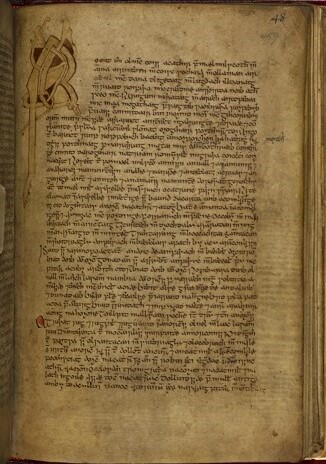
There is evidence, however, that the couple and text were widely known among Irish literati. As the work’s early editor, Kuno Meyer, notes, there is a reference to Líadain as a renowned poet in the introduction to “The Lament of the Old Woman of Beare,” and a tenth-century metrical treatise offers one of her stanzas in our text as an example of treochair metre (8-9).
Given that the preservation of much of Old Irish literature can be attributed to Christian churchmen (the same is also true for other pagan literatures), some of the Christian themes in the story have been thought overlays. For example, in the forward to her translation of the text, Moireen Fox refers to “acts of pious vandalism” enacted against ancient works, the forcing of “old legends into the boundaries of the new faith” (7).[4] Be that as it may, thinking of an earlier, “pure” literature as somehow sullied by Christian influences short-changes the vibrant, syncretic culture that preserved it—a culture that one sees refracted through Líadain and Cuirithir’s lives.
What we have in the Comrac Líadaine ocus Cuirithir is a narrative that relates the following. Recounted in prosimetrum form, we learn that Líadain, a celebrated poet from Corkaguiney, a barony in County Kerry that comprises most of the Dingle Peninsula, is on tour in Connacht.
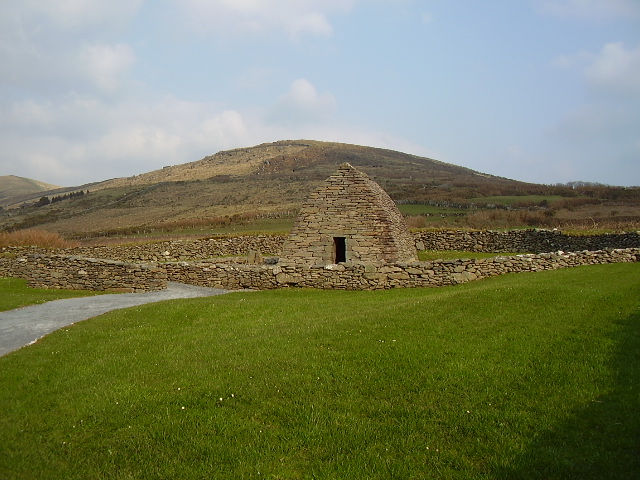
While there, she meets Cuirithir, also a poet—both likely lived in the seventh century—with whom she falls in love. Cuirithir urges that they unite, saying that if they had a son, he would surely be famous, but Líadain resists. She does not want her agreed-upon schedule of travels and literary engagements jeopardized. Instead, she tells Cuirithir that once she has finished, he can leave Connacht to come visit her at her home.

When Cuirithir finally heads south to meet Líadain, he accompanies her to the religious man Cummaíne Fota, and they place themselves under anmchairde, ‘soul-friendship’ (cf. Lat. amicitia). Though the text is sparse in the details, one can infer that this is Líadain’s idea. This notion of soul-friendship is something treated often in later theological treatises, and we can think especially of St. Aelred of Rievaulx (c. 1110-1167). Spiritual marriage, as a concept, becomes a repeated theme in hagiography and in the lives of religious women, especially during the High and Late Middle Ages. What is so intriguing about the story of Líadain and Cuirithir is how early it is—ninth or the beginning of the tenth century.
One can only guess at the reasoning behind Líadain’s decision to become a nun. Perhaps it was entirely religious. Perhaps she also did not want to give up her intellectual and artistic calling to have child after child—a valid response that women of different cultures and time periods during the Middle Ages shared. One need only peruse a work like Hali Meiðhad to catch a glimpse of how motherhood was perceived by some.
Nonetheless, much of the verse in the text is filled with regret. The two seem to occupy separate oratories, overseen by the monk Cummaíne Fota, and are only allowed to walk about at different times. During one of these times, Cuirithir, now a monk himself, is in his hut, and Líadain speaks to him. Cuirithir replies:
Beloved is the dear voice that I hear,
I dare not welcome it!
But this only do I say:
Beloved is this dear voice! (19)[5]
To this Líadain responds:
The voice which comes to me through the wattled wall,
It is right for it to blame me:
What the voice does to me, is
It will not let me sleep. (19)[6]
It is very clear that both long for physical and emotional closeness, and Líadain asks Cummaíne for a reprieve from their separation, which is granted so long as a student in the community sleeps between them as a guard. It must be concluded that this does not work, for Cuirithir is moved to another location and then goes on pilgrimage within Ireland. Líadain sets out in search of him, and it is during her final soliloquy that the power of her poetry truly comes to the fore. Although she made her choices, the remorse is profound:
Cen áinius
in chaingen dorigenus:
an rocharus rocráidius.
Joyless
The bargain I have made!
The heart of him I loved I wrung.
Ba mire
ná dernad a airer-som,
manbad oman ríg nime. (22)
‘Twas madness
Not to do his pleasure,
Were there not the fear of the King of Heaven. (23)
Ní bú amlos
dó-sum in dul dúthracair:
ascnam sech péin hi pardos.
To him the way he has wished
Was great gain,
To go past the pains of Hell into Paradise.
Becc mbríge
rocráide frim Cuirithir:
fris-seom ba mór mo míne.
‘Twas a trifle
That wrung Curithir’s heart against me:
To him great was my gentleness.
Mé Líadain,
rocarus-sa Cuirithir:
is fírithir adfiadar.
I am Liadain
Who loved Curithir:
It is true as they say.
Gair bá-sa
hi coimthecht Cuirithir:
fris-som ba maith mo gnás-sa.
A short while I was
In the company of Curithir:
Sweet was my intimacy with him.
Céol caille
fomchanad la Cuirithir
la fogur fairce flainne.
The music of the forest
Would sing to me when with Curithir,
Together with the voice of the purple sea.
Doménainn
ní cráidfed frim Cuirithir
do dálaib cacha ndénainn.
Would that
Nothing whatever of all I might do
Should wring the heart of Curithir against me!
Ní chela!
ba hé-som mo chrideṡerc,
cía nocarainn cách chenae.
Conceal it not!
He was the love of my heart,
If I loved every other.
Deilm ndegae
rotetaind mo chride-sae,
rofess nícon bíad cenae. Ce. (24)
A roaring flame
Dissolved this heart of mine,
However, for certain it will cease to beat. (25)
The text clarifies afterwards that “how she had wrung his heart was the haste with which she had taken the veil” (27).[7] When Cuirithir hears that Líadain is searching for him, he takes to the sea and travels to distant lands to continue his pilgrimage. They never see one another again. While we could view Cuirithir’s harsh parting as vengeful, it could also be attributable to a wish to help both of them live out their vows—though these are vows upon which Líadain insisted. However, Líadain’s feelings towards her earthly love never diminish: “The flagstone upon which he was wont to pray, she was upon it till she died. […] And that flagstone was put over her face” (27).[8] We are reassured, though, that her soul is in Heaven.
Part of what makes this account so moving is the tension between their commitments and their love for one another, especially on Líadain’s side. She voices far more of the lines in the text than Cuirithir. Indeed, one could argue that she is the central figure, being that she is the one so vexed and pulled by competing desires. She wants to have it all and cannot, a situation that can ring as true today as ever it did. We also get a strong sense of her talent as a poet, a gift that she did not wish to squander, and indeed, it is her fame, not her partner’s, that is preserved in Irish literary history. When Cuirithir arrives at her abode in Munster, he addresses her thusly:
O woman with the firm foot,
Thy like for great fame I have not found:
Under nun’s veil will not be known
A woman with more sense. (17)[9]
But with her strength, intellectual abilities, and renown also came great sorrow, a sorrow she was never able to overcome.[10]
Hannah Zdansky, Ph.D.
University of Notre Dame
[1] For the edition and translation utilized here, see Liadain and Curithir: An Irish Love-Story of the Ninth Century. Ed. and Trans. Kuno Meyer. London: D. Nutt, 1902. Available online here: https://books.google.com/books/about/LIADAIN_AND_CURITHIR.html?id=qkNT8Th48DsC&printsec=frontcover&source=kp_read_button#v=onepage&q&f=false.
[2] See a catalogue description of the manuscript here: https://www.vanhamel.nl/codecs/Dublin,_Trinity_College,_MS_1337. Some of the manuscript, which has been split into different volumes, is available here: https://www.isos.dias.ie/english/index.html. However, our tale has not yet been digitized.
[3] See a catalogue description here: https://www.bl.uk/catalogues/illuminatedmanuscripts/record.asp?MSID=7375&CollID=8&NStart=5280.
[4] See Liadain and Curithir. Trans. Moireen Fox. Oxford: B. H. Blackwell, 1917.
[5] “Inmain guthán rocluniur, / fáilte fris nocho lamur, / acht is ed atbiur nammá: / is inmain in guthán sa” (18).
[6] “Guth domadbat trie clethae / is maith dó domincrechae: / is ed dogní frim in guth, / nachomléci do chotlud” (18).
[7] “Is é didu crád dorat sí fair-som a lúas rogab caille” (26).
[8] “Ind lecc fora mbíd som ac ernaigthe, robói sí for inn leicc sin co n-erbailt sí […]. Conid ind lecc sin dochóid dar a hagaid-si” (26).
[9] “A ben cosind remorchois, / ní fúar do ṡét di márchlois, / nícon festor fo chailliu / banscál badid cíallaidiu” (16).
[10] For further studies, see those listed here: https://www.vanhamel.nl/codecs/Comrac_Liadaine_ocus_Cuirithir.

